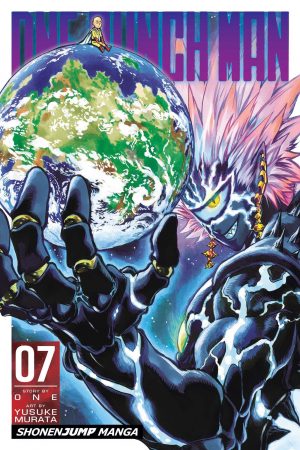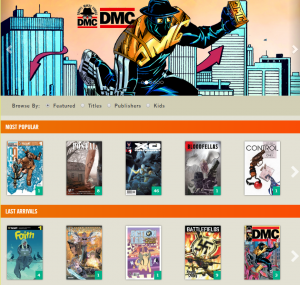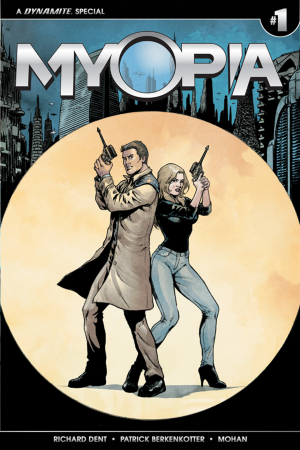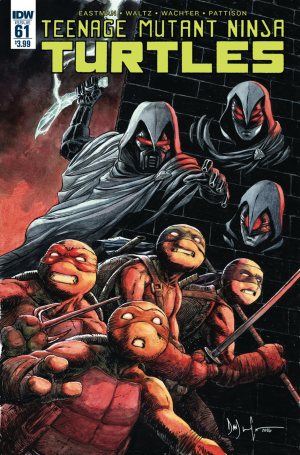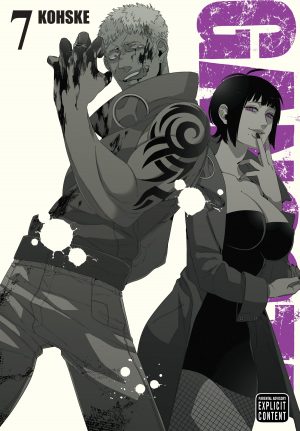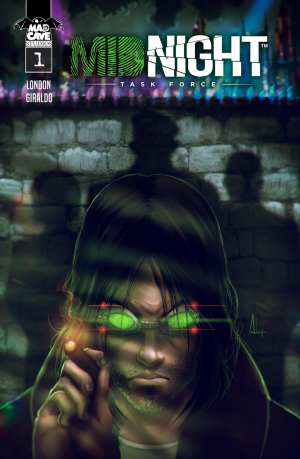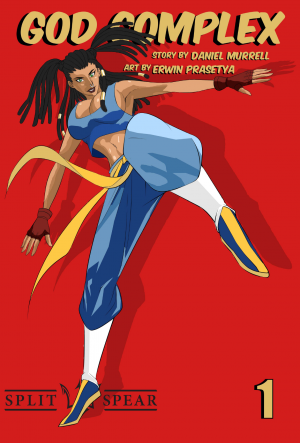June of this year as the conclusion of Andrew Maclean's Head Lopper, a dark, funny mix of high fantasy adventure and quirky humor. The story follows the titular warrior who embarks on a dangerous quest with only his wits, a few weapons, and the talking head of Agatha the blue witch. Head Lopper was a tour de force of action, humor, and graphic storytelling that managed to improve on Maclean's previous excellent graphic novel Apocalyptigirl. The future looks bright for the series with a new arc announced from Image comics and a bonus-laden trade to be released in October. Andrew Maclean was kind enough to talk with us about Head Lopper, Apocalyptigirl, and his influences.
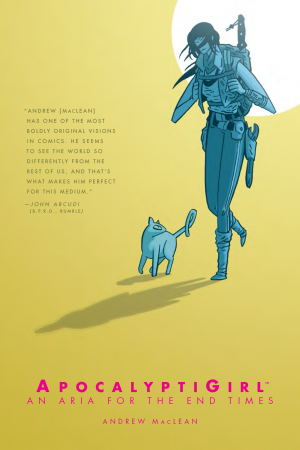 ASA: I'm excited to talk about Head Lopper, but before that, I'm curious about your background in comics. To a lot of fans, myself included, it seems like you appeared on the scene with a fully formed style and sensibility with Apocalyptigirl? How did you get into making comics and what was the first published work?
ASA: I'm excited to talk about Head Lopper, but before that, I'm curious about your background in comics. To a lot of fans, myself included, it seems like you appeared on the scene with a fully formed style and sensibility with Apocalyptigirl? How did you get into making comics and what was the first published work?
ANDREW: The first comic I ever drew was called Meatspace, it was written by writer Josh Gorfain. I think you can probably still get it at least on Comixology or something - but looking at that you'd be able to see that my style really wasn't fully formed yet and honestly, I think style, for me anyway, is this ever-morphing thing that is always being added to and subtracted from. But yeah, I did a story for Dark Horse Presents right before ApocalyptiGirl called SNIP SNIP, and I think that's probably around the time that I started to zero in a little bit on the way I wanted to draw.
ASA: While we're on the subject of somewhat earlier work, how did Apocalyptigirl come together? It's rare to see an adventure comic be released as a graphic novel instead of in some serialized format, so what was it like having a full, long-form story as your first major project?
ANDREW: I had already done a little bit with Head Lopper (self-publishing) when I started talking with Dark Horse, but they were really supportive of finding a good project for me. They sort of pitched me the formula of a 100 page 6x9 graphic novel and asked if I wanted to do some Head Lopper or some more SNIP SNIP stuff. At the time I had longer stories in mind for those two though so I offered them a third idea that I thought would fit the 100-page format well. That, of course, was ApocalyptiGirl.
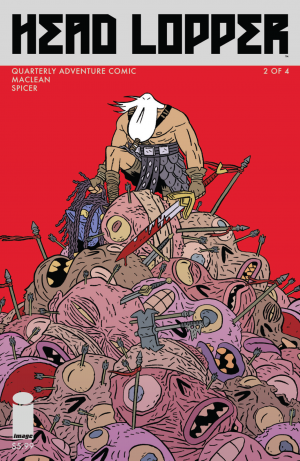 ASA: Onwards and upwards, let's talk Head Lopper. Firstly, perhaps even more than your other work, Head Lopper is clearly a passion project for you, so what has it been like to transition it from a truly indie book to an Image book with a much wider audience?
ASA: Onwards and upwards, let's talk Head Lopper. Firstly, perhaps even more than your other work, Head Lopper is clearly a passion project for you, so what has it been like to transition it from a truly indie book to an Image book with a much wider audience?
ANDREW: Luckily both titles have felt like passion projects. I've been really lucky. But I'm a bit close to it, so it's tough to tell which has the bigger following, not to mention, new readers stumble upon both titles all the time. Sometimes word travels slowly. Mostly I try not to think about it too much and just focus on making the things.
ASA: One thing that was especially impressive about Head Lopper was that you created a high-fantasy story with loads of humor without it ever becoming a parody. Was it always your intention to play the fantasy straight and mix in some humor or did the style of the world evolve as you went?
ANDREW: Actually, I never meant for it to be a comedy. I wanted to make a comic that was simple, fun, but hopefully still badass. The jokes crept in immediately, though, partially to entertain myself, and partially because they were just kind of already there. You just needed to point them out. Having a talking head wasn't meant to be funny, but it made me chuckle right off the bat. Also - even when I did put jokes in I didn't think anyone would actually laugh. I think people's senses of humor is a little darker than I gave them credit for.
That said, where that original vision was sans humor - as humor became a characteristic of the thing, its been remained important to me that it doesn't become a parody. I love the genre too much to poke fun at it.
ASA: The relationship between Agatha and Norgal is so weird, specific, and fun. Do you see them as friends, enemies, or some odd-couple amalgamation of the two?
ANDREW: I won't give away too much because we have more to learn about their strange bond. But I will say they are still more enemy than friend going into this next season. We'll get much more into it in the future of course, but they are still bound to each other out of necessity - otherwise, Norgal would toss her into the sea.
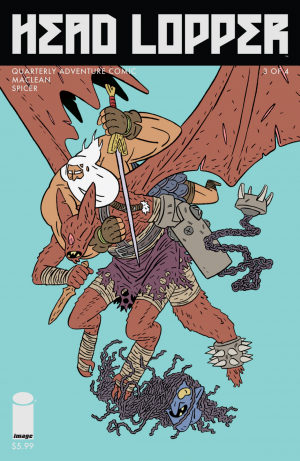 ASA: Beyond the adventures of Norgal, the story contains a massive fantasy story of dead kings, deceitful stewarts, and many, many monsters. What was your basic idea for the story of Barra and Lulach?
ASA: Beyond the adventures of Norgal, the story contains a massive fantasy story of dead kings, deceitful stewarts, and many, many monsters. What was your basic idea for the story of Barra and Lulach?
ANDREW: I wanted a character in Lulach that was Grima Wormtongue from The Lord of the Rings, except Lulach can swing a sword and looks at the villain, Barra, as a father figure - and the rest just kind of filled itself in. Also, I was reading a fair bit of The Song of Ice and Fire at the time, so the whole Barra/Lulach/Royal Family storyline, I think, took on some of that Game of Thrones-style intrigue.
ASA: My favorite moment in the series is the ongoing, one-sided conversation between Agatha and a skull in issue #3. What was your idea for her as a character and her detached (literally) take on reality?
ANDREW: I just think the idea of her is funny. Making myself laugh is a fun way to make a book so if I have an idea that cracks me up I'd like to find a home for it. Well, at some point I started writing down a bunch of really simple Agatha jokes that are either her by herself or with very little else. The spider in the nose gag from issue 2 and the talking to the skull gag from issue 3 were some of those one-off jokes.
ASA: Your art seems to specialize in creative character designs and kinetic action sequences. What's your artistic process look like? Do you spend a lot of time on designs and layout?
ANDREW: I spend a fair amount of time on character design. When its right, its right, though. So sometimes you find the right look on the first pass, and you have to trust your gut. Sometimes if takes a bunch of iterations. As for layouts, I don't put a ton of effort into them on paper, but I start thinking about layouts while I write the scripts. So once I sit down with paper and pencil I at least have some idea of what I'd like to do.
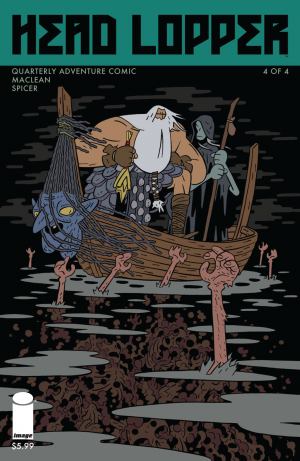 ASA: Your work has been compared to that of Mike Mignola with a regularity you may well be tired of, but I noticed in Head Lopper what looked like designs based on Aztec and Gaelic tribal designs. What sort of influences influenced Head Lopper?
ASA: Your work has been compared to that of Mike Mignola with a regularity you may well be tired of, but I noticed in Head Lopper what looked like designs based on Aztec and Gaelic tribal designs. What sort of influences influenced Head Lopper?
ANDREW: Actually, I don't mind the comparison - because it's true. A big part of what made me read comics as an adult, and in turn, made me want to make my own, was finding Mike's work. It showed me that comics can be about anything and can be drawn in any style. It really helped me look into what other types of comics might be out there.
I love all kinds of fantasy of course, but I enjoy greek and roman mythology, and heavy metal music, and I try to just squish all my favorite things into everything. I also wanted the island of Barra based on Scotland - and Barra, in some form, is a real place. I just love looking at pictures of Scotland and thought it would be wonderful to draw a lot of what I saw.
ASA: You recently announced that there will be more Head Lopper coming. Did you always have it in mind that these characters could support more adventures, or were you surprised to find you had more stories when the first was done?
ANDREW: Yeah, I've always pictured it as an ongoing thing. From the very start in fact. But Image has been really easy to work with so when we started out they asked how many issues I had in mind, and I told them I would need four big ones to tell this story. The said cool. That was that. And around issue 3, I hit them back up and just told them I wanted to make more, and clearly they were on board because issue 5 will be out in March 2017!
ASA: Finally, is there anything you are willing to tease about the next arc of Head Lopper and what's in store for Agatha and Norgal?
ANDREW: Yeah sure. I introduced a character in issue 3, Zhaania Kota Ka. This next arc revolves largely around her... and a few other new faces.
 Okay, moving onto the names now. I just have to point something out here; I would have most likely referred to the bananya's by colour, if not numbers, so I'm a little disappointed that the creators chose to name one of the bananya's Black Bananya. Really? Where is the creativity? I guess it's not all bad, though; Tabby and Banankyo (everybody's Madonna) are pretty um unique. Banankyo or Maddonya (the only female bananya) is hilarious; she is aloof, cute and maybe a little stuck up. Tabby, on the other hand, is so sweet; it's so obvious how infatuated he is with Banankyo.
Okay, moving onto the names now. I just have to point something out here; I would have most likely referred to the bananya's by colour, if not numbers, so I'm a little disappointed that the creators chose to name one of the bananya's Black Bananya. Really? Where is the creativity? I guess it's not all bad, though; Tabby and Banankyo (everybody's Madonna) are pretty um unique. Banankyo or Maddonya (the only female bananya) is hilarious; she is aloof, cute and maybe a little stuck up. Tabby, on the other hand, is so sweet; it's so obvious how infatuated he is with Banankyo.
